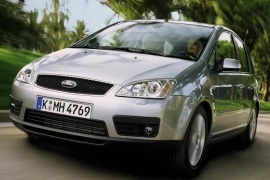
FORD C-Max
Generations Timeline, Specs and Pictures

Ford didn’t seem to understand by 2014 that the MPV market belongs to the French.
One after another, apart from the VW Sharan and its siblings, everyone else failed. But Ford didn’t give up and tried again with the C-Max. Based on the successful Ford’s Global C platform, which was also used for the compact car Focus, it developed an MPV with claimed car-like abilities and very spacious.
The egg-shaped unibody MPV kept some design cues from the Focus range. It had a bold styling, a mix between a hatchback and an MPV. In addition to the overfenders for the wheel arches, the Ford stylists made a median ascending line ended into a more rectangular shape of the taillights.
Inside, the engineers installed more convenience features such as a bigger, refrigerated console and a better infotainment system. A seven-seat minivan was available on the European market as Grand C-Max. But it was axed from North America even though it was announced.
The powertrain range comprised two diesel engines and two gasoline units, mated to either a 5-speed manual for the base units, 6-speed manual or 6-speed automatic (dual-clutch) for the more powerful engines and upper trim levels.
But if the first generation was sold in over 1.2 million units, the second did not perform too well. And in 2018 the sales stopped for the C-Max in the U.S. and 2019 in Europe.

A very practical C-segment family car, the Ford C-Max offered new levels of style to the Multi-Activity Vehicle market.
The new C-Max was designed to bring enhanced comfort and safety with the latest technologies available.
Offering seating for 5, the C-MAX was a sporty small MPV appealing to a broad age range.
New for 2010, Ford introduced the 1.6-liter EcoBoost unit that provided a good fuel economy compared to larger gasoline engines that produced similar power.
Both the exterior and the interior design were created using the Ford’s kinetic design form language, the same that was used for the successful Fiesta, Kuga and Mondoe.
As the previous model, the new C-Max was equipped with three individual 40/20/40 folding seats in the second row. For an additional fee, the C-Max could be equipped with the Comfort System that allowed the center seat to be folded away.
The high driving position provided amazing visibility, while the high mounted gear knob and center console were easy to action.
An impressive array of top-notch technologies that were usually found in more premium vehicles, the C-Max could be equipped with numerous features that enhanced practicality and safety.
Among the most important equipments were the Active Park Assist, Blind Spot information system, Speed limiter, power child locks, power operate tailgate, a rear-view camera and others.

The facelift version of Ford’s compact MPV was unveiled at the 2006 Bologna Motor Show and arrived at dealerships in spring 2007.
Ford dropped the Focus C-Max nameplate and replaced it with just C-Max in order to better define the car as part of the car maker’s MPV lineup, dubbed Max. While the engine range remained the same as before, the C-Max suffered an updated visual makeover to bring it in line with Ford’s new Kinetic Design language. Although the car wasn’t developed based on the Kinetic concept, Ford applied a series of retouches both to the exterior and interior to make the car more appealing.

The MPV market was still significant at the beginning of the ‘2000s, and Ford tried to get more from it by introducing the C-Max in 2003.
Ford managed to build a broader range of vehicles based on its C1 platform, which was used for the second generation of the Focus. The C-Max appeared as an important contender for the Renault Scenic and Citroen Picasso. Unlike its rivals, it relied on the rear independent suspension that made it more comfortable.
From the outside, its front fascia was unmistakably related to the Focus. It featured similar triangular, curved headlights and a similar-looking grille. From its sides, it resembled a Focus station wagon with a higher greenhouse and door panels. In the rear, it sported a set of taillights mounted high on the D-pillars.
Inside, the C-Max offered a roomy interior for five adult passengers. Despite sharing the same wheelbase with the Focus, it allowed better legroom for the rear seat passengers since its seats were higher. To make the car feels more like a compact hatchback, Ford installed a higher center console with a shorter gear-stick.
Under the hood, the carmaker installed a choice of four gasoline and diesel engines, paired as standard to a manual gearbox. For selected versions, Ford offered an automatic transmission as well.























































